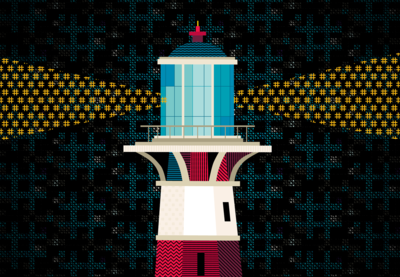On August 23, 2007, product designer Chris Messina proposed the idea of the Twitter hashtag—or as he called it, a “# (pound) for groups.” By 2009, the Twitter search tool made hashtags official. Within six years of Messina’s suggestion, they spread to Tumblr, Instagram and Facebook. The rest is hashtag history.
From this symbol, stories, memes, movements and revolutions spread to people’s feeds—from thoughts into actions.
And while hashtag activism has its critics, it’s undeniable that often-ignored voices found communities and a wider audience finally willing—or forced—to hear them. Three black women—and then, a movement—declared, #BlackLivesMatter. High school student Jason Fong—and then, thousands—told #MyAsianAmericanStory. Opponents of the terrorist group Boko Haram demanded, #BringBackOurGirls. Native defenders of water and land rallied behind #NODAPL. Survivors of sexual violence said, #MeToo. Even here at Teaching Tolerance, a headline dared to suggest: “The Revolution Will Be Tweeted.”
Educators, too, have discovered hashtags—and each other.
For years, educators have utilized platforms like Twitter and Instagram to engage in less rigid—and less costly—forms of professional development. Researchers from Sam Houston State University showed that educators appreciated that social media was easy to use, saved time and fostered encouragement. And, in giving people a sense of belonging, it felt more fulfilling than traditional PD. Educators could personalize their learning at their pace. As far back as 2013, a survey of 755 U.S. teachers found that Twitter combated feelings of isolation. Within hashtags and chats, there existed collaboration and burgeoning communities.
Systemic power dynamics persist, of course. A feature story about the trend of teacher influencers on Instagram may still include an all-white cast of educators earning a second living off social media, cute classroom décor and lessons that are far from “controversial.” A ranking of top teacher influencers on Twitter may still feature 10 white people—and no one else.
But more diverse communities of social justice educators are also thriving on social media. They redefine professional development as we once knew it. And they provide platforms to educators who, historically, might have been marginalized—educators now considered thought leaders, exemplars and experts.
When José Vilson co-founded the EduColor collective in 2012—not coincidentally the year of Trayvon Martin’s death and the birth of #BlackLivesMatter—he saw that many of his well-followed white colleagues refused to talk about issues of race and social justice. They told him Twitter wasn’t the right platform for in-depth conversation or “controversy.”
“And EduColor begged to differ,” Vilson says. “EduColor said, ‘No, actually, we can have this conversation right here, right now.’”
Many educators of color now lead these conversations on Twitter and Instagram. And in more ways than one, they’ve shifted the narrative.
Disrupting the Narrative of Professional Development
The literary brain trust of Julia Torres, Tricia Ebarvia, Lorena Germán and Dr. Kim Parker first formed through serendipity. The four educators—who now teach in Denver, Philadelphia, Austin and Boston, respectively—serve as the founders and stewards of #DisruptTexts, a grassroots movement and Twitter chat designed to challenge the traditional literary canon and how we teach the so-called classics, if we teach them at all.
All four were doing this work in their classrooms and on the ground. Ebarvia and Parker had connected as Heinemann Fellows; Torres and Germán had connected through the National Council of Teachers of English (NCTE). But they all came together in 2018 because they wanted to bring the conversation to a wider community of language arts teachers.
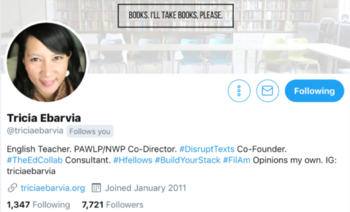
“A lot of teachers said that they would be very interested in some work like that,” says Ebarvia. “To be able to think deeply about it and have a space for it.”
So the slow chats began. They resonated. For many—white men, especially—the challenge to the “classics” struck a nerve. For others, the challenge struck a chord. The women behind #DisruptTexts quickly saw how many of their peers had never received this sort of PD or asked these sorts of questions of their reading lists. After Germán led a discussion of To Kill a Mockingbird—the conversation all four women cite as the one that generated the most backlash and learning—the need for #DisruptTexts became clear. As did its reach.
You feel affirmed. You find a community of like-minded folks. You're going to find strength in that—and boldness.
“For me, it was like, ‘Wow, this really is educational for a big percentage of people in our field,’” Germán says. “That was my eureka, my aha moment of how important and necessary and even new-for-a-lot-of-people this work is.”
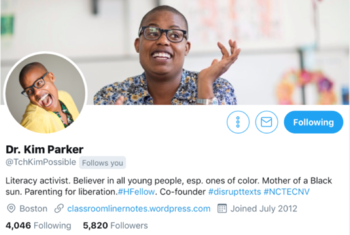
The story of #DisruptTexts so rapidly gaining a foothold in the educator community underscores the potential reach and value of social media as a tool for professional development. Together, Torres, Ebarvia, Germán and Parker have reached thousands more educators than they could have reached separately and on the ground. It’s a testament to their work, but also, they say, a testament to opportunities presented by social media platforms.
“Not everyone can show up to a professional development workshop on the ground,” Parker explains. “The potential to reach people is so much broader using social media and other online resources. And it’s really powerful because I have met more people, and the work that we do and I do has resonated with more people—far more than a local context. And it’s because they can participate when they want, they can catch up on things, they can have discussions in their own networks.”
Parker and her colleagues echo many of the same reasons reflected in surveys of teachers who use social media as PD: It’s free, it’s more accessible and it’s more long-lasting. Conversations once contained to a room can now spread into classrooms across the country.
For many, this opened doors to learning anti-bias practices never offered to them in person. Teacher educator Britt Hawthorne has more than 18,000 followers on Instagram, and she says social media changed the PD game.
“It gives us access that we’ve never had before,” Hawthorne says. Not only does using Instagram mean she doesn’t have to pay hundreds of dollars or travel to attend a PD; it means she can use Instagram Live to connect with teachers for free, whether they watch it in real time or on replay. It also means she can learn on her time, in her way.
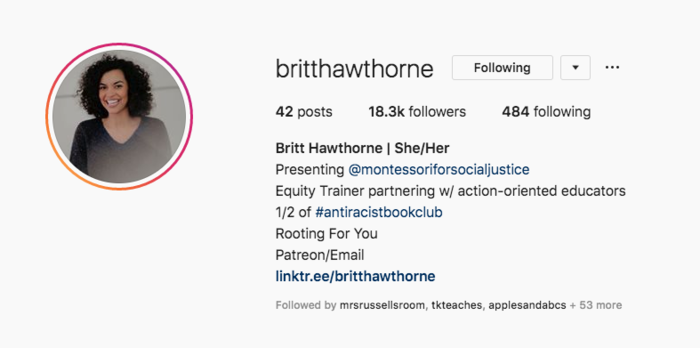
“So many times, professional development only happens in the summer when teachers are trying to rejuvenate, or it may happen after school when working parents have to plug back into home life or on the weekends when we’re already committed,” Hawthorne says. “[With social media,] it’s always there for us. … It also supports different learning styles. The captioning of the story, the reading of the caption, the visual aspect of it—things that sit-and-get presentations are not necessarily going to support or promote.”
Perhaps most importantly, social media offers educators access to professional development and presenters they might otherwise never encounter at their school, especially if they work in homogenous environments.
“It’s really important to consider the perspectives of other people and also just to recognize that maybe the way that you’ve always considered things to be done isn’t always the only right way to do things,” says Liz Kleinrock. The Teaching Tolerance Award-winning educator runs the Instagram account Teach and Transform, where she has become a go-to resource for social justice education, especially for elementary teachers.
“[Social media] allows you to get an insider’s peek into what other teachers are doing and learn from their best practices as well, which really just expands your horizon,” she says.
It’s that aspect of social media PD that Ebarvia credits for not only the growth of #DisruptTexts’ following, but for her own growth as an educator.
“I think pushing myself to understand more, to educate myself and to do my own critical self-reflection … came from Twitter,” Ebarvia says. “It came from being challenged to think about my role as an educator. I don’t think I would have gotten that in person because, honestly, there’s not enough in-person work around equity and racial justice. And I don’t think I would’ve been able to get that deep level of professional development had it not been for the engagements that I’ve had with people on Twitter.”
We have Ebarvia’s certainty on this. Parker says earnestly that “this is bigger than us now.” Julia Torres says the group’s overarching ethos is that “we’re stronger together.” All of this and more make it clear that, for many educators doing anti-bias work—and especially educators of color—social media’s value is not just in the access it grants them to learning. It’s about the access it grants them to community—and to validation.
Disrupting the Narrative of Isolation
As a prominent member of both the #DisruptTexts and #EduColor communities, Julia Torres understands the feeling that draws many educators to these hashtags and each other: isolation. Before her current job in the Montbello community of Denver, she experienced that feeling of working in predominately white spaces, seemingly alone in championing social justice education. On social media, she says, she could counter that isolation.
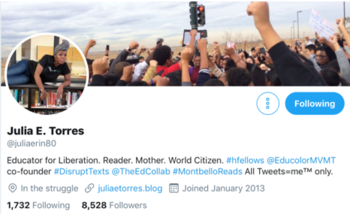
“I really gain a lot of strength professionally and personally from the community,” she says. It’s a sentiment echoed by many of her peers who joined these online spaces at a moment when they felt most alone in this work and on the verge of burning out.
“The online environment not only makes community possible,” Parker says. “It makes sustenance possible.”
For José Vilson, this is not an incidental outcome; it’s an outcome by design. EduColor’s chosen platforms might have been new-age, but the mission to attain equity and justice in public education was grounded in a decades-old legacy. A legacy of organizations like the National Colored Teachers Association (later the American Teachers Association), which was providing support for black teachers and demanding better for black students nearly half a century before Brown v. Board of Education.
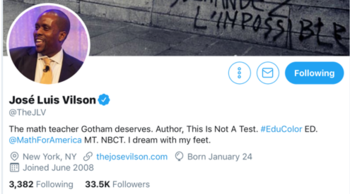
“When I think about EduColor, I often think about the work that has happened way before me,” Vilson says. “Educators who have been covertly or overtly trying to have discussions around children of color and the pedagogies and practices that matter.”
On social media, these conversations happen overtly and collaboratively. Almost everyone interviewed for this story spoke about these online communities as a collective space where they always had access to the wisdom of their peers. Rather than alone in this work, they feel surrounded by people who want to help them achieve it, always ready to suggest resources. They’ve sought PD but also found allies—and friends.
It’s a space, according to Torres, where educators can “publicly show up as we are, educators looking to disrupt the status quo, showing up as our whole and full selves, fully accepted by each other, if no one else.”
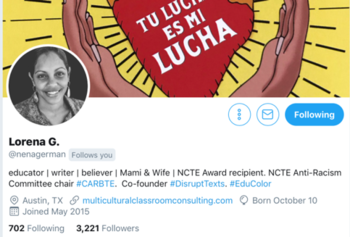
That acceptance within the community contains power that surges beyond social media. Lorena Germán talks about how teaching can feel isolating because you’re often the only adult in a room. Your activism is often unseen and often thankless—but it’s activism, still.
“I don’t have a march every day that I go to,” Germán says. “But every day I go to my classroom, and that’s where I metaphorically march. In EduColor, I find other educators [who] see it the same way. …
“You feel affirmed. You find a community of like-minded folks. You’re going to find strength in that—and boldness.”
Disrupting the Narrative of Expertise
With strength comes power. For many of these social justice educators, social media provided something that the old guard of education and its gatekeepers never did: a chance to become leaders in their field and have their expertise rightly recognized.
This isn’t lost on the leaders of #DisruptTexts, who realize that, in a different way, their leadership in the field in itself is disrupting an old narrative and forcing people to confront old biases.
“I think that I’m proudest that it’s an effort that’s led by women of color,” Parker says. “I’m most proud that people are trying and are disrupting and are committing—and then are giving us credit. That’s really powerful because I think that shifts the power dynamic.”
Germán agrees. She has worked in predominantly white school systems where teachers of color were not seen as leaders in the English department. So she, too, takes pride in the fact that others are coming to #DisruptTexts for guidance.
“Not just because it’s me,” she says, “but because of the idea that you’ve got these four expert, knowledgeable women of color who are saying, ‘We have something to contribute to the field of English education.’”
Their contributions, cited by outlets such as the Chicago Tribune and NPR, clearly filled a void of courageous leadership in the field of English education. At a time when our nation was grappling with its history, its relics of past injustice and its present-day issues of race and identity—an ongoing process—too few educators were willing to bring these conversations into their classroom.
This included educators of every discipline who had amassed large followings on social media. Before starting her Read Like a Rockstar Instagram account, Naomi O’Brien took note of the silence. Police brutality against black people hit headline after headline, but never the feeds of white educators she followed.
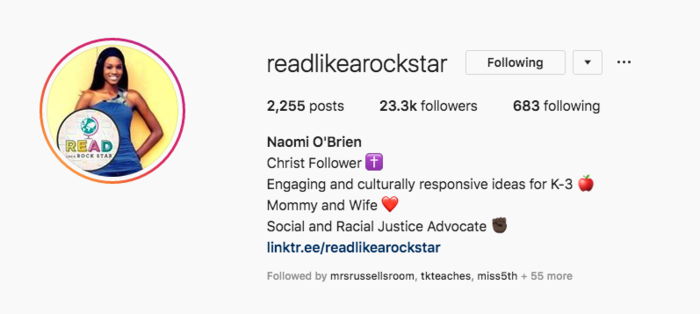
“They have so much to say about every other issue going on in the country, but when it came to issues affecting the black community, they had nothing to say,” O’Brien remembers. “And a few of them I considered good enough friends that I thought they would speak up, or I thought I really knew their character. And in private messages, they would just say, ‘This is my brand,’ or ‘Well, I’m uncomfortable talking about that.’”
O’Brien stepped into that space and now has more than 20,000 followers. On a platform where many educators profit from neutrality and cosmetic classroom tips, O’Brien stands alongside leaders like Kleinrock, Hawthorne and Lanesha Tabb, who educate and offer concrete strategies for bringing social justice topics into the classroom.
They do so collaboratively, understanding that their platform can amplify the voices of other educators. For example, Kleinrock handed off her well-followed Instagram story feed to Amanda Tooley, a teacher on the front lines of the Los Angeles teacher strike earlier this year. And all have used their platforms to highlight others’ work.
“I think it’s really important because everybody has the opportunity to lead,” Hawthorne says. “In a traditional professional development, there are gatekeepers who decide who’s going to lead the PD. With Instagram, you can choose if you want to lead; you choose what to share. It allows me to empower other people and share the mic in a way that isn’t always easy to do.”
This harkens back to what Torres described as the ethos behind #DisruptTexts and EduColor: this notion that “we are stronger together.” This cooperative philosophy has helped educators of color find platforms previously denied to them, despite their expertise.
“We’ve built any number of leaders,” Vilson says. “People who felt like they were silenced, who felt like they were ignored, and are now able to stand at the forefront of what we would consider the educational movement for our students.”
And those leaders of the movement are modeling a new way of doing things—a better way.
Modeling a New Narrative
When Vilson looks back at EduColor’s founding, he sets it against the backdrop of the burgeoning #BlackLivesMatter movement of the time. Twitter chats for educators already existed, but, as Vilson puts it, “nothing that actually grasped at the heart of the more human issues that were happening.”
But the goal of EduColor’s first leaders was not just to “go there”; the goal was to show there. “It felt appropriate,” Vilson says, “to create a space that not only discussed race and social justice issues, but a place that actually spoke to the immediate and the controversial in a way that would model for the rest of the world.”
This mission informs so much of the online community work of today’s leading social justice educators. EduColor leaders, for example, were quick to counter the narrative of increased security at schools in response to concerns about mass shootings, underlining how this negatively affects students of color and contributes to the school-to-prison pipeline.
More recently, this looked like Liz Kleinrock modeling how to talk to her third-grade students about consent in the wake of the Supreme Court confirmation hearings for Brett Kavanaugh. The lesson—and especially the simple, but powerful, anchor chart—went viral. Kleinrock faced pushback and comment-section ugliness. But ultimately, she says, modeling a practical approach to a seemingly difficult conversation was worth it.
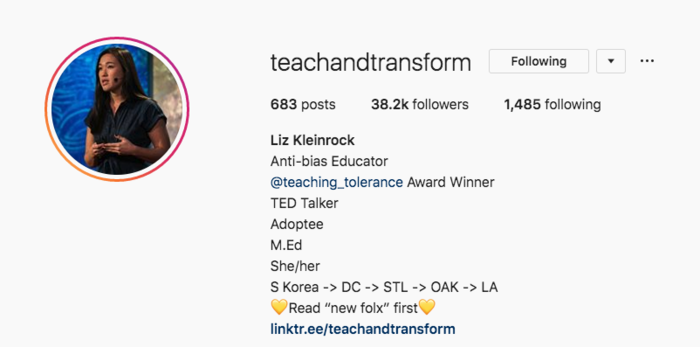
“It was amazing to get messages from parents saying, ‘Thank you. I now have the language to talk about this with my kids, and I really just had no idea how to approach it,’” Kleinrock says. “I had teachers in India and Brazil—all over the world—send me their versions of their consent posters, which was amazing. I never would have dreamed that something like that could have happened.”
For Kleinrock, the reason for putting these strategies out there is simple: “I’m hoping that my platform shows people who believe in this theory and this way of teaching how it can look and what it can sound like in concrete ways in the classroom,” she says.
She keeps every message from students who see her work and say they now want to be teachers—gifts she says are priceless and reminders that people can still be called into this vital profession.
But modeling also has a profound impact on veteran educators, perhaps especially white educators who may be not be as actively involved but are willing to learn.
“It has been advantageous for both people of color and for white people,” Vilson explains. “There’s any number of white people who have pointed to EduColor as the space where they were able to hold their transformational space. … They start getting acclimated to the ways that a lot of us discuss our issues. So that’s been a real powerful thing.”
For this reason, those at the forefront of these online social justice education communities underscore the importance of using social media to model critical conversations, discomfort and a willingness to learn in real time.
“I know I want to share something when I have learned it and I didn’t know it before,” Hawthorne says. “If I didn’t know that, there might be one other person out there [who] didn’t know it either. That transformation will lead to our liberation.”
Offline Engagement
The reminders of these educators’ reach come via direct messages and comments, via keynote invites, citations and TED Talks. Reminders that, while this work takes place on social media, it also takes form in the real world.
In the classroom, syllabi have already changed as a result of #DisruptTexts, EduColor and these leaders. Naomi O’Brien says a teacher reached out recently, saying it had never occurred to her that she should be paying attention to the identities of characters in the books available to her students, most of whom are black. She thanked O’Brien for pointing out the importance of representation.
“Stuff like that feels really good to hear,” O’Brien says. “Because then I think of these students that I’ll never meet that are now getting books and lessons that they need—that will positively impact their lives.”
On the ground, something’s stirring. Teachers nationwide are striking for better pay, yes, but also more equitable environments for their students. And more and more, teachers who learn about social justice education online are taking that new knowledge to their colleagues.
“I think it’s those teachers who are looking for this professional development who are going to be the ones to push the system forward,” Tricia Ebarvia says. “It’s one piece to push the system to change.”
Dr. Kim Parker agrees. She hopes people see that a movement can start with ideas.
“While Twitter is wonderful, and it does connect us sort of digitally, I do wonder if then that would catalyze people to get together on the ground,” Parker says. “That people will have the tools gleaned from social media to then do on-the-ground work, to share that work and to then gather forces to be even more powerful.”
It may sound lofty for those who have long considered social media more of a cultural toxin* than a cultural tool. But for many educators, these communities instilled hope.
“I think I’ve learned that a lot more people care than I thought they did,” O’Brien admits. “And a lot more people really do want to do the right thing. They just may need the right tools, the right education, the right information.”
In the figures behind collective movements like #EduColor, #DisruptTexts, #ClearTheAir and more, you see leaders trying to provide those tools, their goals rooted in a decades-long struggle: to support educators like them and, ultimately, to support students underserved by the system.
In those hashtags—just four connecting lines—lies something beyond words: community and a source of strength and support.
“I knew I wasn’t alone,” Britt Hawthorne says now.
“I just needed to find my people.”
Collins is the senior writer for Teaching Tolerance.
*While this article highlights ways in which social media has helped more people access professional development and community in the social justice education sphere, we also recognize the moral qualms inherent in using these platforms. Twitter and Instagram (and by extension, Facebook) continue to cause legitimate concerns when it comes to privacy, harassment and online hate.
How #ClearTheAir Was Born
By Val Brown
There was a time when I swore that I would never join any social media. I could not fathom it as a place where meaningful interactions could occur. Besides, I had “friends” in real life. Who needed or wanted more strangers in my business? As with many important things I have learned over the years, it was a child who helped me see the world differently.
As I obsessively monitored my students’ digital behavior in our online learning community, Edmodo, I didn’t see the immaturity or bullying I had anticipated. Instead, I saw the power of learning together in virtual communities. It surprised me, and I wanted that for myself as an educator, to fight the isolation I often felt in the profession.
So, with a little encouragement, I joined Twitter and sought to create a space where I could learn from and with others. I immediately saw this new virtual world as an opportunity to give others access to learning experiences and conferences that I had the privilege to attend. I adopted this attitude: “If I am learning, then you are learning.” There were no more locked doors, and, in fact, I was holding the door open for anyone to enter so that we could engage in meaningful conversations.
I noticed all throughout 2016 that there were few, if any, educators having conversations about the hateful rhetoric surrounding the presidential campaign. I recognized the immediate impact of then-candidate Trump’s words on our students, but I felt very alone in that. Sure enough, the election came and went without too many educators I followed on Twitter taking a stand on anything other than innovation. In December 2016, I just wanted us to be able to talk about what we had all experienced. I wanted us to clear the air about any number of topics that we remained silent about for far too long. I decided on the morning of December 30, 2016, that I wanted to have that conversation, and by that evening #ClearTheAir was officially founded.
#ClearTheAir is a group of educators who believe:
• Community, learning and dialogue are essential to our personal and professional development;
• We have the power and responsibility to lay the foundations necessary to create a more just and equitable society;
• Education is a vehicle for social change.
We understand that we are not going to fix the issues we talk about—racial and social justice in schools—in a one-hour Twitter chat, so we don’t try to. In our quest to make our schools racially and socially just, our goal is to learn together, grow together, be accountable to one another and know that we can count on one another when we stumble.
As a result of #ClearTheAir, participants have said they now have the courage to act outside of our virtual communities, whether it is leading their own #ClearTheAir groups around text or presenting their learning at local and national conferences.
The next chapter of #ClearTheAir is still being written, but the most important chapter is already well established: We have found one another.
